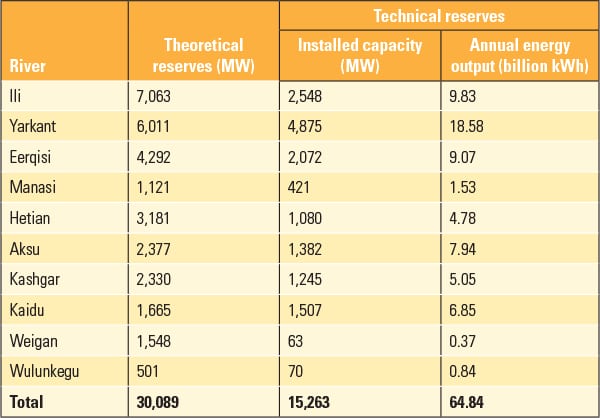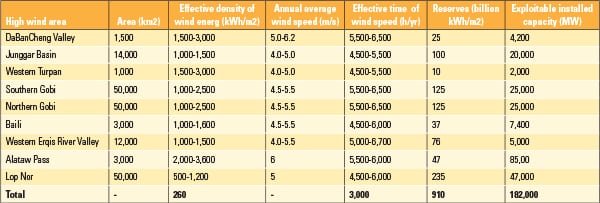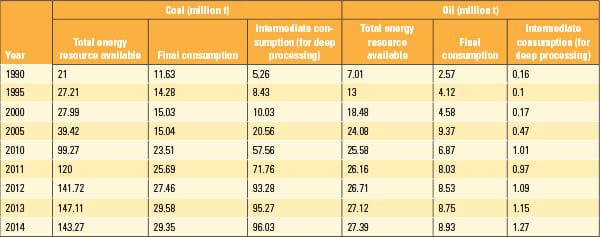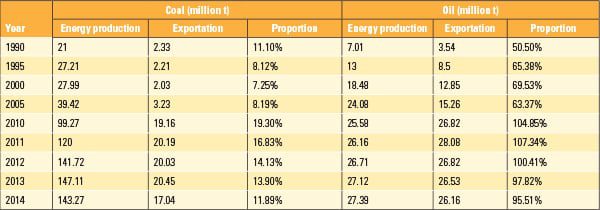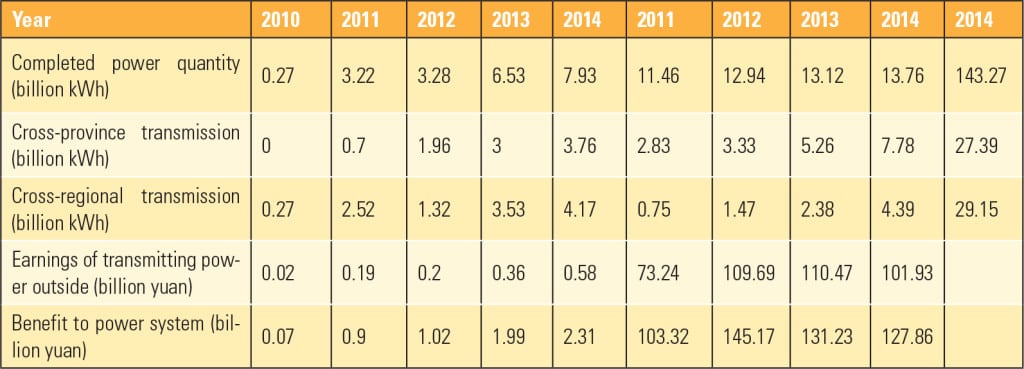The Energy Industry in Xinjiang, China: Potential, Problems, and Solutions
The autonomous region of Xinjiang has an important strategic position in China’s economy—which consumes more energy than any other nation—yet several conditions limit the most effective use of its fuels. This article provides an overview of the situation.
Since ancient times, the Xinjiang Uygur Autonomous Region (Xinjiang) has been in a particularly important position in China’s energy strategy. Xinjiang is located in the northwest of China and comprises an area of 1.66 million square kilometers (km2), accounting for one-sixth of China’s land mass (Figure 1). Located in the hinterland of Asia and Europe, it borders on Russia, Kazakhstan, Kyrgyzstan, Tuck Kyrgyz, Pakistan, Mongolia, India, and Afghanistan, with a land border more than 5,600 km.
- Western powerhouse. Location of Xinjiang Uygur Autonomous Region (Xinjiang).
Xinjiang is not only an important energy source for China in the 21st century, but it is also a large channel connecting China with Russia and other central Asian countries. Therefore, promoting development of the energy industry in Xinjiang is of extremely vital significance not only for the economic and social development of the region itself but also for China’s energy supply and energy security.
Energy Development Potential
Xinjiang is positioned as China’s ‘‘national energy strategy base’’ because of its rich energy resources. And, due to its superior geographical position, energy development in Xinjiang has a huge market. In addition, the technical level of energy exploitation and utilization in Xinjiang has gradually improved under relevant policy guidance. All these circumstances position Xinjiang’s energy industry for growth
Total reserves of natural gas, coal, and other fossil resources in Xinjiang account for more than 20% of China’s energy reserves, placing it in first place for fossil fuel reserves. Xinjiang’s wind power and solar energy resources are ranked second, while its theoretical hydropower reserves rank fourth in the country.
Fossil. Fossil energy resources in Xinjiang account for 38%, 21.5%, and 23.3% of national reserves respectively. There are 24 coal fields in Xinjiang with predicted resource reserves greater than 10 billion tons (t). Of those, Schallsee and Large South Lake-Wutong Snap are each projected to contain more than 100 billion t; Zhundong and Yining are projected at over 300 billion t, and Turpan-Hami is predicted at more than 500 billion t.
Oil reserves in Xinjiang total 23.4 billion t, and gas resources are roughly 13 trillion m3, accounting for 23.3% of the entire onshore gas resources in China (Table 1). Among them, the Tarim, Junggar and Turpan-Hami basins contain 20.9 billion t of oil and 10.9 trillion m3 of gas, respectively, accounting for 25.5% and 27.9% of the total onshore oil and gas resources in China. Xinjiang is considered by geologists to have the most potential of all provinces for oil and gas exploration in China.
Table 1. Fossil energy resources in Xinjiang. Source: Resources and Economy Atlas of Xinjiang Uyghur Autonomous Region, 2012, SinoMaps Press
The fossil energy distribution of Xinjiang is shown in Figure 2.
- Many resources. This map shows the fossil energy distribution in Xinjiang. Source: Resources and Economy Atlas of Xinjiang Uyghur Autonomous Region
Renewables. Renewable energy (RE) in Xinjiang has huge exploitation potential. Projections for RE resources, including hydro, wind, and solar are shown in Table 2.
Table 2. Renewable Energy statistics in Xinjiang. Source: Resources and Economy Atlas of Xinjiang Uyghur Autonomous Region
In Xinjiang, there are approximately 570 rivers and 270 mountain springs with surface flow of 112 billion m3 and recoverable ground water of 25.2 billion m3. Theoretical reserves of water resources for hydropower production are 38,178.7 MW, or 5.6% of the national total. The quantity that can be technically exploited is 16,564.9 MW; the quantity that can be economically exploited is 15,670 MW. Water resources in Xinjiang are mainly concentrated in the Ili, Eerqisi, Kaidu and Yarkand rivers. Among them, the Ili River has the biggest theoretical reserves of 7,063 MW, in which 38 power stations can be developed. The total capacity could be as high as 2,548 MW, with annual power production up to 9.83 billion kWh. The main rivers in Xinjiang are shown in Figure 3, and the data are shown in Table 3.
- Hydro-rich. Xinjiang has numerous rivers with substantial hydropower potential. Source: Resources and Economy Atlas of Xinjiang Uyghur Autonomous Region
Table 3. Resources data for the main rivers in Xinjiang. Source: Resources and Economy Atlas of Xinjiang Uyghur Autonomous Region
Wind energy is mainly distributed in northern and eastern Xinjiang. Wind power reserves are 960,000 MW theoretically, and 134,300 MW can be technically exploited. The wind energy distribution in Xinjiang is shown in Figure 4, and the specific resource reserves are shown in Table 4.
- Wind potential. Xinjiang also has substantial unexploited wind resources. Source: Resources and Economy Atlas of Xinjiang Uyghur Autonomous Region
Table 4. Resource reserves of the nine high-wind areas. Source: Resources and Economy Atlas of Xinjiang Uyghur Autonomous Region
Xinjiang is rich in solar energy resources and receives annual radiant energy of 5,430 to 6,670 MJ/m2 with a sunshine duration of about 2,550 to 3,500 hours per year. Xinjiang’s annual radiation intensity is 15% to 25% higher than other parts of China with the same latitude and in the Yangtze River region. Throughout the year, approximately 250~325 days have more than 6 hours of sunshine. The distribution of the annual insolation in Xinjiang is shown in Figure. 5. With good atmospheric transparency and less cloud cover, the Hami district in particular is rich in solar energy resources.
- Substantial insolation. Xinjiang has high annual insolation, with the best resources concentrated in the eastern regions. Source: Resources and Economy Atlas of Xinjiang Uyghur Autonomous Region
Current Energy Exploitation and Utilization in Xinjiang
Rich energy resources promoted the development of the energy industry in Xinjiang, and a long-term energy development plan has been made based on the province’s unique characteristics. However, in recent years, the trends of a single industrial structure and a higher proportion of coal energy utilization are rising. Meanwhile, energy resource waste, environmental pollution, and unconscionable use all exist in the production process.
Coal, Oil, and Natural Gas. Coal production in Xinjiang was, respectively, 24.35 and 143.27 million t in 2005 and 2014. From 2000 to 2014, annual oil production increased from 18.48 million t to 27.39 million t, accounting for 13.04% of total oil production in China. Annual production of natural gas is generally increasing from 10.66 billion m3 to 29.15 billion m3, accounting for 21.93% of natural gas production in China and ranking second nationwide.
By the end of 2014, the detected rate of prospective oil and gas reserves were 18.5% and 11.8%, respectively. The lower detected rates indicate that oil and gas possess great potential for future exploration and exploitation. Table 5 shows the coal, oil and gas production in Xinjiang from 2005 to 2014.
Table 5. Fossil energy production in Xinjiang. China Statistical Yearbook, 2015, National Bureau of Statistics of China
As shown in Figure 6, the proportion of coal production has been increasing yearly generally, while the proportion of oil and gas production is declining.
- Surging coal. Coal production Xinjiang has grown in recent years, taking a larger share of the overall energy production. Source: China Statistical Yearbook
Within Xinjiang, coal consumption has been rising generally while oil and natural gas consumption has been decreasing. The energy consumption structure in Xinjiang is illustrated in Figure 7, and the production of various RE resources is shown in Table 6.
- Coal use growing. Energy consumption in Xinjiang in recent decades has been dominated by coal. Source: China Statistical Yearbook
Table 6. Power production of renewable energy in major years of Xinjiang. Source: China Statistical Yearbook
Renewables. Renewable generation in Xinjiang comes largely from hydro and wind sources. Recently, photovoltaic (PV) solar power has achieved rapid development. The structure of the installed renewable capacity of Xinjiang is shown in Figure 8.
- Thermal-heavy. The overwhelming proportion of existing installed capacity of Xinjiang is thermal. Source: China Statistical Yearbook
By the end of 2014 the installed capacity of non-fossil energy reached 15,690 MW, accounting for 34.44% of the total installed power capacity and higher than the 30.84% in 2013. Generation from non-fossil sources was 25.93 billion kWh—20.28% of the total 127.86 billion kWh. That percentage increased by 4.46% compared with the 15.82% in 2013.
Although development has been quick, RE currently provides only a small portion of power in Xinjiang.
Energy Industry Barriers
China attaches great importance to the energy development of Xinjiang. In May 2010, the Central Committee and the State Council held a forum in Beijing, putting forward the development plan to promote the leap-forward development of Xinjiang. From then on, major energy companies in Xinjiang increased their exploration and exploitation intensity. Although Xinjiang has good growth opportunities, development of the energy industry still faces two main problems: proved reserves are low, resulting in a high reserve-production ratio, and the percentage of primary energy that is exported is too high.
High Reserve-Production Ratio. As of 2014, proved coal reserves reached 307 billion t, accounting for 14.02% of predicted reserves of 2.19 trillion t. Even if coal production maintains an annual growth rate of 20%, existing reserves are sufficient for more than 100 years. The third round evaluation of oil and gas resources in Xinjiang showed that predicted reserves of oil and nature gas are 20.9 billion t and 10.4 trillion m3, respectively. In 2014, the production of oil and natural gas in Xinjiang were 27.39 million t and 29.15 billion m3, respectively. With this level of production, proved and predictive reserves of oil in Xinjiang can be mined for about 140 and 780 years, respectively, while proved and predictive reserves of natural gas can be mined for 50 and 410 years, respectively.
This phenomenon of low proved reserves and high reserve-production ratio indicates that the strength of exploration and exploitation of fossil energy in Xinjiang is still very weak; however, it also indicates a huge opportunity for future development.
High Levels of Exports. In 2014, 143.27 million t of coal was produced in Xinjiang, of which 96.03 million t were used for processing and conversion, accounting for 67.03% of total production. Quantities for power generation, heating supply and coking were, respectively 42.19, 18.93, 30.65 million t, accounting for 43.93%, 19.71% and 31.91% of intermediate consumption. Only 3.1% of intermediate consumption was used for processing with high technology levels, such as for the coal chemical industry. Therefore, deep processing of coal has huge space for future development.
In 2014, 27.39 million t of oil was produced in Xinjiang, of which 1.27million t were used for processing and conversion, accounting for only 4.64% of the total oil production. The low proportion of processing and conversion of oil indicates that the deep processing industry of oil still has much room to improve in Xinjiang.
The consumption structure of coal and oil of Xinjiang in major years is shown in Table 7.
Table 7. Consumption structure of coal and oil in Xinjiang in major years. Source: China Statistical Yearbook
Also in 2014, coal production in Xinjiang was 143.27 million t, from which the export reached 17.04 million t, accounting for 11.89% of total production. Although the absolute amount of coal export in Xinjiang is continuously increasing, the percentage is decreasing yearly.
In 2014, oil production in Xinjiang reached 27.39 million t, while oil export volume reached 26.16 million t, accounting for 55.60% of the total oil production in Xinjiang, even removing the oil importation of 10.93 million t. Most of the oil production in Xinjiang is transferred to other provinces in the form of primary energy. The primary energy exports from Xinjiang are shown in Table 8.
Table 8. Primary energy export in major years of Xinjiang. Source: China Statistical Yearbook
The large quantity of primary energy exported has become a bottleneck to further development of the energy industry in Xinjiang; the long-term export of primary energy products is bound to weaken the resource superiority of Xinjiang and goes against the long-range and industrial development of its energy industry.
Renewable Energy Problems. Currently, the development of RE in Xinxiang is stable. The government provides much support, attracting many institutional investors at home and abroad. At the same time, the mixed ownership economy was introduced into oil and gas pipeline construction, and the market investment and financing mechanism achieves sound development. However, the development of RE in Xinjiang still has problems.
Hydropower in Xinjiang accounts for only 14.68% of the theoretical reserves and 33.83% of the quantity that can be technically exploited.
By the end of 2014, grid-connected wind power capacity was only 4,810 MW, accounting for 11.76% of the total grid-connected power of 40,890 MW.
Although PV power had a late start, it has achieved rapid development in recent years with various investment promotion, capital introduction, and focused assistance from other provinces.
Meanwhile, the ability to transmit power outside the region is lacking. The weakness of the grid makes transmitting power outside of Xinjiang difficult. The Tianzhong direct current (DC) linr can only deliver 2,000 MW of power currently and and only 8,000 MW by June of 2016. The performance of transmitting power outside of Xinjiang during 2010 to 2014 is shown in Table 9; the cross-province and cross-regional transmission accounts for 25% of the total.
Table 9. Performance of transmitting power outside of Xinjiang during year 2010 to 2014. Source: State Grid Corporation of China
Weak Technology and Workforce Capacity. At present, the professional platform for RE in Xinjiang is poor. Apart from a wind engineering technology center that is under construction, there are no institutions or laboratories specialized in RE research; fewer than 5,000 people are engaged in RE industry research. Therefore, every year Xinjiang needs to attract professional and technical personnel with RE experience either domestically or from abroad.
In addition, local universities have not yet created an RE major; the study of PV and wind power are also not academic subjects, so most specialized personnel are self-taught. Xinjiang has a shortage of RE professionals, aging knowledge, and a short supply of senior specialized and experienced personnel.
The lack of professional talent and lagging education have become the main factors restricting the development of the RE industry in Xinjiang.
Proposed Solutions
Our analysis shows that proved reserves of fossil energy in Xinjiang are relatively low and that the exploitation and utilization rate of RE is insufficient. To solve these problems, multiple plans should be implemented simultaneously.
Increase Energy Production. Xinjiang has abundant energy resources, has been confirmed as one of the five comprehensive energy bases of China, and has been absorbed into “twelfth five-year plan of energy development.” The policy environment is favorable for construction. The exploitation of fossil energy should be strengthened to construct large coal mines and oil and gas production bases. The government should accelerate the examination and approval efficiency and provide fiscal and financial support to the six large coal production bases. Concurrently, exploitation of RE should be accelerated. With peak-shaving support from fossil energy and hydropower, intermittent wind and PV power can be massively constructed to realize the comprehensive utilization of energy.
Improve Energy Transport and Utilization. At present, energy utilization in Xinjiang is insufficient because energy demand for economic development is far below its supply. To solve this problem, energy channels should be constructed to realize the optimal resource allocation of Xinjiang’s abundant energy nationwide.
Achieving that goal would include constructing a strong power grid to transmit power outside of Xinjiang. The first stage would involve three Extra High Voltage (EHV) DC sites in southern Hami-Zhengzhou, northern Hami-Chongqing and in eastern Junggar-Sichuan province. A second project should also be constructed in northwest Xinjiang as a network of 750-kV alternating current. The second stage involve three 1100-kV EHV DC sites in the eastern Junggar-southern Anhui province, eastern Junggar-Jiangxi province and in Ili-Sichuan province. Wind power, thermal power, and PV power should be bundled and transmitted together to realize peak and voltage regulatiion and accelerate the utilization of RE. The proposed plan is shown in Figure 9.
- Power exports. Full exploitation of Xinjiang’s energy resources will require expansion of the region’s ability to export power. A phased implementation plan is shown here. Source: State Grid Corporation of China
Furthermore, gas transmission eastward from Xinjiang should be implemented. All of the local gas, imported gas (from Central Asia and Russia), and coal-based natural gas should be comprehensively considered and transmitted to the southeast coastal region and mid-east region. The construction of transmission pipelines is planned and shown in Figure 10.
- Pipeline needs. Greater natural gas pipeline capacity eastward from Xinjiang should also be added. Source: China National Petroleum Corporation
Meanwhile, the energy utilization of local users should be accelerated. First, the government should implement fundamental public service in urban and rural areas. Second, energy infrastructure construction should be strengthened. For cities with high energy demand, combined heat and power is a good way to realize the multistage utilization of energy. Finally, for significant energy infrastructure construction projects, the government should change the present ”National Loans Account” into financial allocation.
Build a Technology and Talent Base. From above analysis, it is clear that the state of fossil energy in Xinjiang results from two aspects: one is Xinjiang’s small economic capacity, which leads to a small energy demand market, and the other is the low technology level. RE in Xinjiang also has technical issues; therefore, this paper suggests the following solutions.
First, it is important to implement industrial clusters to accelerate technology upgrades that enable the development of related industries (such as natural gas vehicles) from existing dominant industries such as coal, oil, and gas mining. Meanwhile, those industries should be developed with energy conservation and emissions reduction in mind. Currently, the energy industry is progressing from a small-scale development mode to a large one. Large enterprises have more advanced technology for energy acquisition, energy conversion, and environmental protection (such as coal-to-gas). Small businesses should cooperate with the larger organizations to help ensure clean development.
Second, the construction research base should be strengthened and professional talent for RE should be cultivated. It is important to establish technological innovation bases and to actively participate in domestic and international competition. For wind power, grid connection techniques of variable speed constant frequency should be sequentially developed to improve the utilization coefficient of wind. For PV power, progressive techniques of thermoelectricity, chimney power, and solar building should be developed. For small hydropower, techniques of transformation, automation, optimal limits of quantity and capacity should be developed considering Xinjiang’s hydropower conditions.
Furthermore, professional talent cultivation should be strengthened. The major consideration is to introduce talent and retain existing personnel by providing higher payment. Beyond this, local universities and colleges should establish the study of RE to systematically cultivate professionals. However, because of the weak existing foundation, achieving workforce goals by using this method is difficult in the short term.
Necessary Change
Large-scale energy development in Xinjiang provides strong support to industrial development and construction modernization in China; it also provides energy reliability for the development of other provinces. However, the energy industry in Xinjiang is severely limited because it is restricted by the low development level of the local economy and the distance from China’s main energy consumption area.
At present, the state is required to increase Xinjiang’s economic and social development and is asking other provinces to assist. Such assistance could both promote Xinjiang’s development and provide energy security for the larger economy and society, thus promoting the sustainable development of Xinjiang.
This work was supported by the National Natural Science Foundation of China (Grant no. 71271082) and the Fundamental Research Funds for the Central Universities of China China (Grant no. 2014XS53).
—Jinhui Duan, Ming Zeng, and Yanfang Ju are affiliated with the School of Economics and Management, North China Electric Power University; Shuying Wei is affiliated with the College of Geophysics and Information Engineering, China University of Petroleum.





